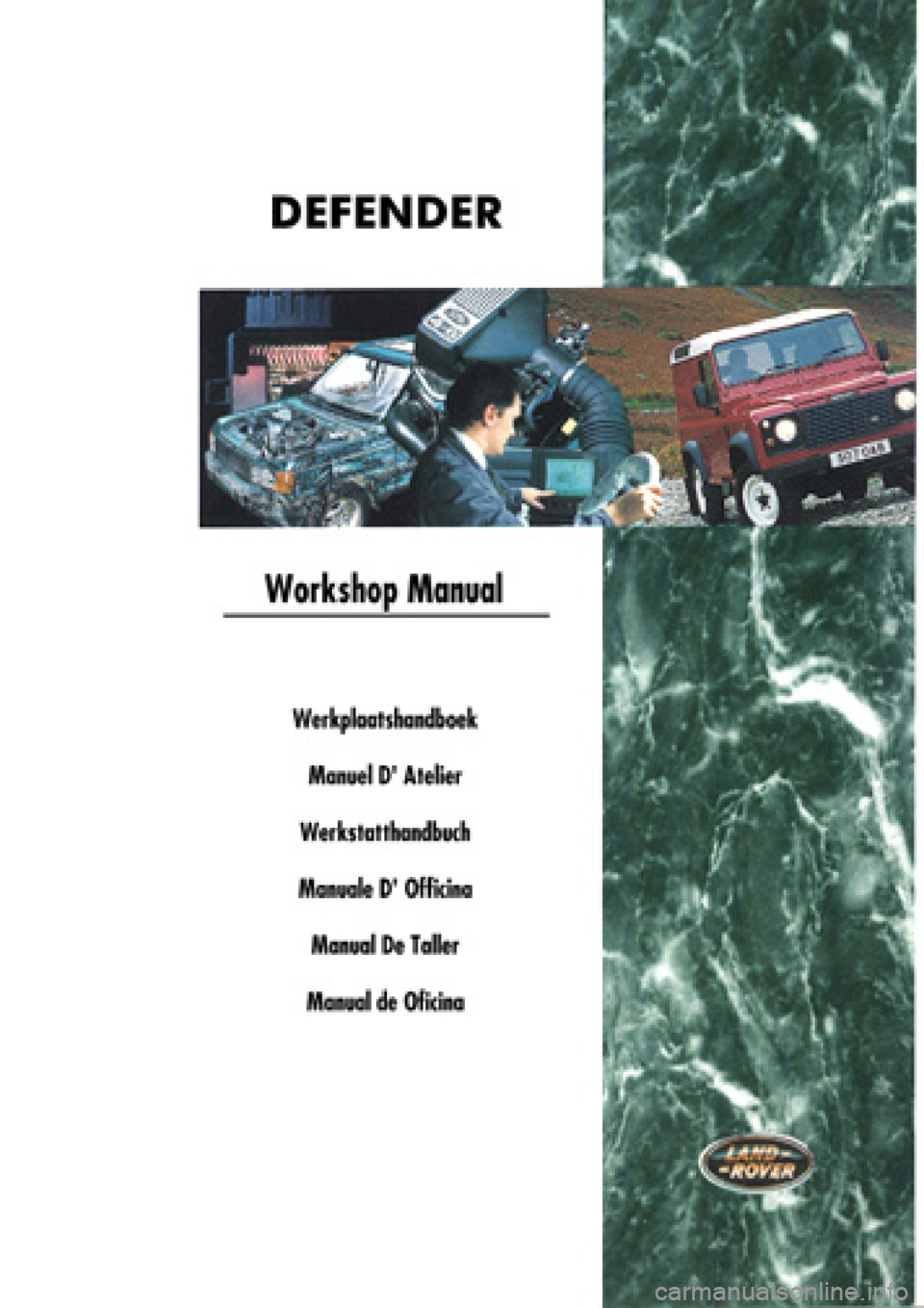LAND ROVER DEFENDER 1996 Workshop Manual
Manufacturer: LAND ROVER, Model Year: 1996, Model line: DEFENDER, Model: LAND ROVER DEFENDER 1996Pages: 455, PDF Size: 6.44 MB
Page 1 of 455

Page 2 of 455

AMENDMENT INSTRUCTION SHEET
DEFENDER WORKSHOP MANUAL
Publication Number LRL 0097 ENG (2nd Edition)
Amendment Number:LD002.99Date:05/99
To ensure that this manual is kept up to date and that a record of amendments to this manual is available, an
Amendment Instruction Sheet will be issued with each set of revised pages.
·The Title page of the Manual is re-issued, and the Part No. has been raised to the next edition. Except for the
Contents pages, all revised and new pages have the issue date at the foot of each page, together with an
indication of whether the pages are revised or new.
·This Amendment Instruction Sheet must be inserted at the front of the manual to indicate that the amendment
has been incorporated. Do not discard previous Amendment Instruction sheets.
·Your manual is only complete to this issue providing all prior Amendments are included.
·The filing instructions give section and page numbers affected. Additional pages or complete new sections may
be issued, insert the pages as instructed.
FILING INSTRUCTIONS
Section Discard Existing
PagesInsert New Pages Reason for Amendment
Title Page Title Page Title Page Part number raised to 3rd edition.
01 - Introduction Contents page Contents page Page numbers amended.
01 - Introduction -
InformationPages 1 and 4 Pages 1 and 4 Special service tools section amended.
04 - General
Specification DataPages 1, 4 and 11 Pages 1, 4, and 11 Correction of typographical errors.
09 - Lubricants, Fluids
and CapacitiesPages 1 to 3 Pages 1 to 3 New anti-freeze introduced.
10 - Maintenance Page 5, and pages
9to15Page 5, and pages
9to14Anti-freeze information updated, page layout
amended.
12 - Engine -
AdjustmentPage 1 Page 1 Warning amended to Caution.
12 - Engine -
Specifications, TorquePages 1 and 2 Pages 1 and 2 Page layout and torque figures amended.
19 - Fuel System -
RepairPages 7 and 9 Pages 7 and 9 Cross references amended.
26 - Cooling System -
RepairPage 4 Page 4 Cross reference amended.
37 - Manual Gearbox -
RepairPages 1 and 6 Pages 1 and 6 Cross references amended.
37 - Manual Gearbox -
Specifications, TorquePage 1 Page 1 Page layout amended.
41 - Transfer Gearbox -
RepairPage 5 Page 5 Correction of typographical error.
Page 3 of 455

Section Discard Existing
PagesInsert New Pages Reason for Amendment
41 - Transfer Gearbox -
Specifications, TorquePage 1 Page 1 Page layout amended.
47 - Propeller Shafts Contents page Contents page Introduction of overhaul section.
47 - Propeller Shafts -
RepairPage 1 Page 1 Introduction of overhaul section.
47 - Propeller Shafts -
OverhaulPage 1 Introduction of overhaul section.
51 - Rear Axle and
Final DriveContents page Contents page Page number amended.
51 - Rear Axle and
Final Drive - RepairPages 1 to 6 Pages 1 to 6 Clarification of wheel nut torque figures.
51 - Rear Axle and
Final Drive -
Specifications, TorquePage 1 Page 1 Page layout amended.
54 - Front Axle and
Final DriveContents page Contents page Correction of typographical error.
54 - Front Axle and
Final Drive - RepairPages 1 to 3 Pages 1 to 3 Clarification of wheel nut torque figures.
54 - Front Axle and
Final Drive -
Specifications, TorquePage 1 Page 1 Page layout amended.
57 - Steering - Fault
DiagnosisPages 5, 10, and
12Pages 5, 10, and
12Cross references amended.
57 - Steering - Repair Pages 3, 5, 8, 9,
13, and 14Pages 3, 5, 8, 9,
13, 14 and 15Torque figures updated, typographical errors
and page layout amended.
57 - Steering -
Specifications, TorquePage 1 Page 1 Torque figure amended.
60 - Front Suspension -
RepairPages 1 to 4 Pages 1 to 4 Clarification of wheel nut torque figures.
64 - Rear Suspension -
RepairPage 1 Page 1 Clarification of wheel nut torque figures.
70 - Brakes -
Description and
OperationPage 2 Page 2 Correction of typographical error.
70 - Brakes - Repair Pages 7, 8, 11, 14,
and 16Pages 7, 8, 11, 14,
and 16Clarification of wheel nut torque figures.
70 - Brakes - Overhaul Page 1 Page 1 Page layout amended.
74 - Wheels and Tyres Contents page Contents page Additional page in repair section.
Page 4 of 455

Section Discard Existing
PagesInsert New Pages Reason for Amendment
74 - Wheels and Tyres
- RepairPages 1, 2, and 6 Pages 1, 2, 6, and
7Cross references amended and clarification
of wheel nut torque figures.
76 - Chassis and Body
- RepairPage 21 and
pages 34 to 37Page 21 and
pages 34 to 37Page layout and typographical errors
amended.
86 - Electrical Contents page Contents page Page numbers amended.
86 - Electrical -
Description and
OperationPages 4 to 6 Pages 4 to 6 Page layout amended.
86 - Electrical - Repair Pages 11 and 24 Pages 11 and 24 Cross reference and typographical error
amended.
Page 5 of 455

01
04
05
07
09
10
12
17
19
26
30
33
37
41
47
51
54
57
60
64
74
70
75
76
80
82
84
86
88Workshop manual
DEFENDER 300Tdi
This manual covers vehicles from
1996 model year
01 INTRODUCTION
04 GENERAL SPECIFICATION DATA
05 ENGINE TUNING DATA
07 GENERAL FITTING REMINDERS
09 LUBRICANTS, FLUIDS AND CAPACITIES
10 MAINTENANCE
12 ENGINE Tdi
19 FUEL SYSTEM Tdi
26 COOLING SYSTEM Tdi
30 MANIFOLD AND EXHAUST SYSTEM
33 CLUTCH
37 MANUAL GEARBOX
41 TRANSFER GEARBOX
47 PROPELLER SHAFTS
51 REAR AXLE AND FINAL DRIVE
54 FRONT AXLE AND FINAL DRIVE
57 STEERING
60 FRONT SUSPENSION
64 REAR SUSPENSION
70 BRAKES
74 WHEELS AND TYRES
76 CHASSIS AND BODY
80 HEATING AND VENTILATION
82 AIR CONDITIONING
84 WIPERS AND WASHERS
86 ELECTRICAL
88 INSTRUMENTS
Publication Part No. LRL 0097 ENG (3rd Edition)
Published by Rover Technical Communication
Ó1999 Rover Group Limited
Page 6 of 455

INTRODUCTION
1
INFORMATION REV: 05/99 INTRODUCTION
This workshop manual covers vehicles from 1996
model year onwards. Amendments and additional
pages will be issued to ensure that the manual covers
latest models. Amendments and additions will be
identified by the addition of a dated footer at the
bottom of the page.
This Workshop Manual is designed to assist skilled
technicians in the efficient repair and maintenance of
Land Rover Defender 300Tdi, Td5, and V8i vehicles.
Individuals who undertake their own repairs should
have some skill and training, and limit repairs to
components which could not affect the safety of the
vehicle or its passengers. Any repairs required to
safety critical items such as steering, brakes,
suspension or supplementary restraint system should
be carried out by a Land Rover Dealer. Repairs to
such items should NEVER be attempted by untrained
individuals.
WARNINGS, CAUTIONSandNOTESare given
throughout this Manual in the following form:
WARNING: Procedures which must be
followed precisely to avoid the possibility
of personal injury.
CAUTION: This calls attention to
procedures which must be followed to
avoid damage to components.
NOTE: This calls attention to methods
which make a job easier or gives helpful
information.
DIMENSIONS
The dimensions quoted are to design engineering
specification. Alternative unit equivalents, shown in
brackets following the dimensions, have been
converted from the original specification.REFERENCES
References to the left or right hand side in the manual
are made when viewing the vehicle from the rear.
With the engine and gearbox assembly removed, the
crankshaft end of the engine is referred to as the front.
To reduce repetition, some operations covered in this
Manual do not include reference to testing the vehicle
after repair.
It is essential that work is inspected and tested after
completion and if necessary a road test of the vehicle
is carried out, particularly where safety related items
are concerned.
REPAIRS AND REPLACEMENTS
When replacement parts are required it is essential
that Land Rover parts are used.
Attention is particularly drawn to the following points
concerning repairs and the fitting of replacement parts
and accessories: Safety features embodied in the
vehicle may be impaired if other than Land Rover
parts are fitted. In certain territories, legislation
prohibits the fitting of parts not to the vehicle
manufacturer's specification. Torque spanner values
given in the Workshop Manual must be strictly
adhered to. Locking devices, where specified, must be
fitted. If the efficiency of a locking device is impaired
during removal it must be replaced with a new one.
Certain fasteners must not be re-used. These
fasteners are specified in the Workshop Manual.
POISONOUS SUBSTANCES
Many liquids and other substances used are
poisonous and therefore must not be consumed. It is
also advisable to keep all substances away from open
wounds. These substances among others include
anti-freeze, brake fluid, fuel, windscreen washer
additives, air conditioning refrigerant, lubricants and
various adhesives.
Page 7 of 455

01INTRODUCTION
2
INFORMATION FUEL HANDLING PRECAUTIONS
The following information provides basic precautions
which must be observed if fuel is to be handled safely.
It also outlines the other areas of risk which must not
be ignored.
This information is issued for basic guidance only, and
in any case of doubt, appropriate inquiries should be
made of your local Fire Officer or Fire Department.
Fuel vapour is highly flammable and in confined
spaces is also very explosive and toxic and when
diluted with air becomes a readily ignitable mixture.
The vapour is heavier than air and will always fall to
the lowest level. It can readily be distributed
throughout a workshop by air current, consequently,
even a small spillage of fuel is very dangerous.
Always have a fire extinguisher containingFOAM CO
2
GAS,orPOWDERclose at hand when handling fuel,
or when dismantling fuel systems and in areas where
fuel containers are stored.
WARNING: lt is imperative that the battery
is not disconnected during fuel system
repairs as arcing at the battery terminal
could ignite fuel vapour in the atmosphere.
Always disconnect the vehicle battery BEFORE
carrying out work on the fuel system.
Whenever fuel is being handled, transferred or
stored, or when fuel systems are being dismantled
all forms of ignition must be extinguished or
removed, any lead lamps used must be flame
proof and kept clear of spillage.
No one should be permitted to repair components
associated with fuel without first having had fuel
system training.Hot fuel handling precautions
WARNING: Before commencing any
operation requiring fuel to be drained from
the fuel tank, the following procedure must
be adhered to:
1.Allow sufficient time for the fuel to cool, thus
avoiding contact with hot fuels.
2.Vent the system by removing the fuel filler cap in
a well ventilated area. Refit the filler cap until the
commencement of fuel drainage.
Fuel transfer
WARNING: Fuel must not be extracted or
drained from any vehicle while it is
standing over a pit.
The transfer of fuel from the vehicle fuel tank must be
carried out in a well ventilated area. An approved
transfer tank must be used according to the transfer
tank manufacturer's instructions and local regulations,
including attention to grounding of tanks.
Fuel tank removal
AFUEL VAPOURwarning label must be attached to
the fuel tank upon removal from the vehicle.
Fuel tank repair
Under no circumstances should a repair to any tank
be attempted.
Page 8 of 455

INTRODUCTION
3
INFORMATION SYNTHETIC RUBBER
Many 'O' ring seals, flexible pipes and other similar
items which appear to be natural rubber are made of
synthetic materials called Fluoroelastomers. Under
normal operating conditions this material is safe, and
does not present a health hazard. However, if the
material is damaged by fire or excessive heat, it can
break down and produce highly corrosive Hydrofluoric
acid which can cause serious burns on contact with
skin. Should the material be in a burnt or overheated
condition handle only with seamless industrial gloves.
Decontaminate and dispose of the gloves immediately
after use.
If skin contact does occur, remove any contaminated
clothing immediately and obtain medical assistance
without delay. In the meantime, wash the affected
area with copious amounts of cold water or limewater
for fifteen to sixty minutes.
RECOMMENDED SEALANTS
A number of branded products are recommended in
this manual for use during maintenance and repair
work.
These items include:
HYLOMAR GASKET AND JOINTING COMPOUND
and
HYLOSIL RTV SILICONE COMPOUND.
They should be available locally from garage
equipment suppliers. If there is any problem obtaining
supplies, contact the following company for advice
and the address of the nearest supplier.
MARSTON LUBRICANTS LTD.
Hylo House,
Cale Lane,
New Springs,
Wigan WN2 1JR
Tel 01942 824242USED ENGINE OIL
WARNING: Prolonged and repeated
contact with engine or motor oil will result
in the removal of natural fats from the
skin, leading to dryness, irritation and dermatitis.
Used engine oil contains potentially harmful
contaminants which may cause skin cancer.
Adequate means of skin protection and washing
facilities should be provided.
Handling precautions
1.Avoid prolonged and repeated contact with oils,
particularly used engine oils.
2.Wear protective clothing, including impervious
gloves where applicable.
3.Do not put oily rags in pockets.
4.Avoid contaminating clothes, particularly
underwear, with oil.
5.Overalls must be cleaned regularly. Discard
unwashable clothing and oil impregnated
footwear.
6.First aid treatment must be obtained immediately
for open cuts and wounds.
7.Use barrier creams, before each work period, to
help the removal of oil from the skin.
8.Wash with soap and water to ensure all oil is
removed (skin cleansers and nail brushes will
help). Preparations containing lanolin replace the
natural skin oils which have been removed.
9.Do not use gasoline, kerosene, diesel fuel,
petrol, thinners or solvents for washing the skin.
10.If skin disorders develop, obtain medical advice.
11.Where practicable, degrease components prior
to handling.
12.Where there is a risk of eye contact, eye
protection should be worn, for example, goggles
or face shields; in addition an eye wash facility
should be provided.
Disposing of used oils
Environmental protection precaution
It is illegal to pour used oil onto the ground, down
sewers or drains, or into waterways.
Dispose of used oil through authorised waste disposal
contractors. If in doubt contact your Local Authority for
advice on disposal facilities.
Page 9 of 455

01INTRODUCTION
4
INFORMATIONREV: 05/99 ACCESSORIES AND CONVERSIONS
DO NOT FITunapproved accessories or conversions,
as they could affect the safety of the vehicle.
Land Rover will not accept liability for death, personal
injury, or damage to property which may occur as a
direct result of the fitting of non-approved conversions
to the vehicle.
WHEELS AND TYRES
WARNING: DO NOT replace the road
wheels with any type other than genuine
Land Rover wheels which are designed for
multi-purpose on and off road use and have very
important relationships with the proper operation
of the suspension system and vehicle handling.
Replacement tyres must be of the make and sizes
recommended for the vehicle, and all tyres must
be the same make, ply rating and tread pattern.
STEAM CLEANING
To prevent consequential rusting, any steam cleaning
within the engine bayMUSTbe followed by careful
re-waxing of the metallic components affected.
Particular attention must be given to the steering
column, engine coolant pipes and hose clips.
SPECIFICATION
The specification details and instructions set out in
this Manual apply only to a range of vehicles and not
to any one. For the specification of a particular vehicle
purchasers should consult their Dealer.
The Manufacturer reserves the right to vary
specifications with or without notice, and at such times
and in such manner as it thinks fit. Major as well as
minor changes may be involved in accordance with
the Manufacturer's policy of constant product
improvement.
Whilst every effort is made to ensure the accuracy of
the particulars contained in this Manual, neither the
Manufacturer or Dealer, by whom this Manual is
supplied, shall in any circumstances be held liable for
any inaccuracy or the consequences thereof.SPECIAL SERVICE TOOLS
The use of approved special service tools is
important. They are essential if service operations are
to be carried out efficiently, and safely. Where special
tools are specified,only these tools should be used
to avoid the possibility of personal injury or
damage to the components.Also, the amount of
time which they save can be considerable.
Special tools bulletins will be issued periodically giving
details of new tools as they are introduced.
All orders and enquiries from the United Kingdom
should be sent direct to Cartool (UK) Ltd. Overseas
orders should be placed with the local Cartool
distributor, where one exists. Countries where there is
no distributor may order direct from:
Cartool (UK) Ltd.
Unit 3,
Sterling Business Park,
Brackmills,
Northampton,
England, NN4 7EX.
The tools recommended in this Workshop Manual are
listed in an illustrated catalogue, obtainable from:
Land Rover Publications,
Character Mailing,
Heysham Road,
Bootle,
Merseyside, L70 1JL
COPYRIGHT
Ó1999 Rover Group Limited
All rights reserved. No part of this publication may be
produced, stored in a retrieval system or transmitted
in any form, electronic, mechanical, recording or other
means without prior written permission of Rover
Group.
Page 10 of 455

INTRODUCTION
5
INFORMATION JACKING
The following instructions must be carried out before
raising the vehicle off the ground.
1.Use a solid level ground surface.
2.Apply parking brake.
3.Select 1st gear in main gearbox.
4.Select Low range in transfer gearbox.
CAUTION: To avoid damage occurring to
the under body components of the vehicle
the following jacking procedures must be
adhered to.
DO NOT POSITION JACKS OR AXLE STANDS
UNDER THE FOLLOWING COMPONENTS.
Body structure
Bumpers
Fuel lines
Brake lines
Front radius arms
Panhard rod
Steering linkage
Rear Trailing links
Fuel tank
Engine sump
Gearbox bell housing
Jack or support vehicle by axles only.
Vehicle jack
The jack provided with the vehicle is only intended to
be used in an emergency, for changing a tyre. Do
NOTuse the jack for any other purpose. Refer to
Owner's Manual for vehicle jack location points and
procedure. Never work under a vehicle supported by
the vehicle jack.
Hydraulic jack
A hydraulic jack with a minimum 1500 kg, 3,300 lbs
load capacity must be used, see J6083.
CAUTION: Do not commence work on the
underside of the vehicle until suitable axle
stands have been positioned under the
axle, see J6084.
Raise the front of the vehicle
1.Position cup of hydraulic arm under differential
casing.
NOTE: The differential casing is not
central to the axle. Care should be taken
when raising the front road wheels off the
ground as the rear axle has less sway stiffness.
2.Raise front road wheels to enable an axle stand
to be installed under left hand axle tube.